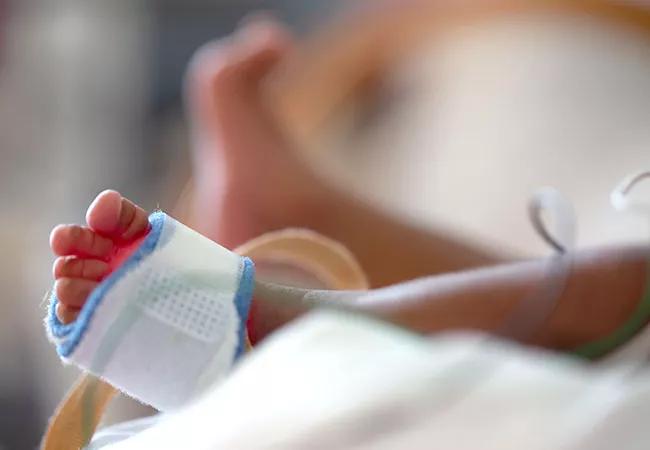Advertisement
Outcomes in youngest patients are mixed, reflecting clinical challenges

Allogeneic hematopoietic cell transplant (allo-HCT) results in adults and older children have continued to steadily improve, with significantly reduced transplant-related mortality and substantially improving long-term survival.
Advertisement
Cleveland Clinic is a non-profit academic medical center. Advertising on our site helps support our mission. We do not endorse non-Cleveland Clinic products or services. Policy
Until recently, it had not been clear whether those benefits extended to infant allo-HCT recipients, who account for only a small percentage of overall transplants and may face higher risks of transplant-related complications than do older patients.
A recent analysis of infant allo-HCT outcomes data from 181 transplant centers worldwide reveals less-than-optimal results, with little to no survival improvements in the last decade for transplant recipients aged 12 months or younger, whether their conditions were malignant or noncancerous.
But the message isn’t necessarily as disheartening as the statistics might indicate, says study co-author and Cleveland Clinic Children’s pediatric hematologist Seth Rotz, MD.
“The results are not as positive as people had hoped; they’re definitely more nuanced,” says Dr. Rotz. “But I don’t think the conclusions are as disappointing as one might think at first. Although it might be subtle, there’s some evidence of progress.”
A closer look at the study findings illustrates his point.
Dr. Rotz and his colleagues retrieved information from the Center for International Blood and Marrow Transplant Research’s database about infants who received first-time allo-HCTs between 2000 and 2014.
The researchers used time-trend analysis to examine overall survival patterns during three periods: 2000-2004, 2005-2009 and 2010-2014. They separately evaluated patients with malignant and nonmalignant disease, looking for factors potentially affecting survival, as well as reviewing the incidence of and risk factors for two major transplant-related organ toxicities: idiopathic pneumonia syndrome (IPS) and sinusoidal obstruction syndrome (SOS).
Advertisement
A majority (81%) of the infant allo-HCT patients had nonmalignant conditions, including inherited bone marrow failure, hemoglobinopathy, severe combined immunodeficiency, osteopetrosis, mucopolysaccharidosis and histiocytic disorder. In this cohort, overall survival significantly improved from the first to the second time period (2000-2009), mainly among patients with immunodeficiencies, but subsequently showed no additional gain. Graft source (hematopoietic cells derived from bone marrow) and donor type (human leukocyte antigen [HLA]-identical sibling) were associated with improved survival over time in infant transplant recipients with nonmalignant disease. The incidences of SOS and IPS did not change in this group over time.
However, among the infant transplant patients with malignant conditions (including acute myelogenous leukemia, acute and chronic lymphoblastic leukemia, and myelodysplastic syndrome/myeloproliferative disorder), overall survival did not improve from 2000 to 2014. Transplant-related mortality and disease-free survival also did not significantly change. Relapse rates in this group increased over the study’s time frame, peaking in the final period of 2010-2014. Patients with a malignant condition had a heightened risk of developing SOS and the incidence of SOS increased with the passage of time — probably due to patients’ prior chemotherapy exposure, a known risk factor for SOS. The incidence of IPS in this group did not change.
“If you look at the data for nonmalignant conditions, these show we’re making a little bit of progress,” at least initially, Dr. Rotz says. The early improvement in survival rates, which plateaued after 2005, probably resulted from practice changes such as:
Advertisement
“Overall, we probably are doing a better job supporting these patients through transplant, making sure we have them on the right antibiotics and the right prophylaxis,” Dr. Rotz says.
The lack of any overall survival improvement in infant transplant patients with malignant conditions may be due in part to selection bias, Dr. Rotz says.
“The number of patients transplanted for malignancies decreased over the study’s time period, because we’ve learned that transplant is not a huge benefit for certain groups,” he says. “We don’t have the data to be certain, but it’s a reasonable hypothesis that what we’re left with are the highest-risk patients. Maybe the study’s findings are cause for some optimism, because we’ve maintained the same survival outcomes but we’re probably transplanting a sicker group of patients.”
The study’s bottom-line findings — flat survival curves for all infant allo-HCT recipients since 2009, substantial relapse risks in patients with malignancies, and the elevated threat of transplant toxicities — emphasize the need for careful patient selection and new approaches to reduce mortality, the study’s authors conclude.
“We’re getting everything we can out of transplants, but they’re only going to cure a subset of patients, probably because of the nature of their disease,” Dr. Rotz says. “We need to do a better job of determining who is and isn’t going to benefit from transplant. And for those whom we don’t think will be cured, we need to think about what alternative clinical trials we should be offering, focusing on things such as gene therapy or immunotherapy.”
Advertisement
Advertisement

Cleveland Clinic, the University of Minnesota and University of Cambridge receive $1M grant to develop point-of-care biosensor for early detection and treatment personalization

Long-acting antiemetics and high-dose steroids key to minimizing acute nausea

Neoadjuvant immunotherapy improves outcomes

Use of GLP-1s and improving cardiovascular health lowers risk of hematologic malignancies

Sexual disorders affect patients across all cancer types

A call for awareness about the importance of genomic testing

Discussing research into improving CAR T-cell therapy efficacy

Ultra-Hypofractionated Whole Breast Irradiation and Partial Breast Irradiation Reduce Many Toxicities